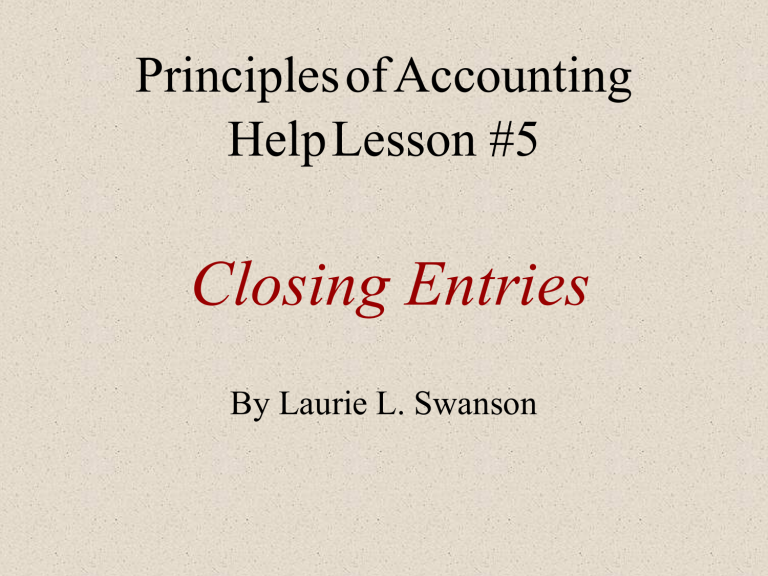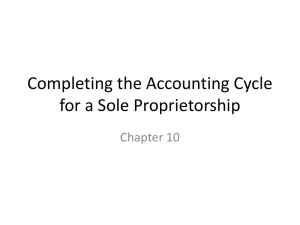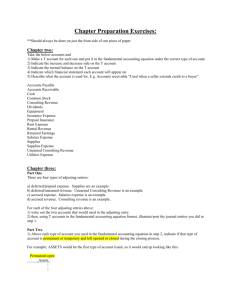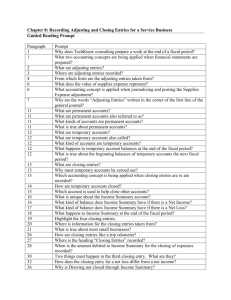Closing Entries

Principles of Accounting
Help Lesson #5
Closing Entries
By Laurie L. Swanson
Principles of Accounting
Help Lesson #5
Viewing this Presentation
Press the F11 key to expand the screen.
Click the button below to navigate to each slide.
Closing Entries
The last step in the accounting cycle is the closing process.
The purpose of the Closing
Entries is to close, or zero out, the balances of certain accounts at the end of the fiscal period.
Temporary Accounts
Temporary accounts are accounts that accumulate balances for one accounting period only. At the end of the accounting period the balances in these accounts are closed, or zeroed out, so that the accounts can begin accumulating new balances that apply only to the current period.
Temporary Accounts
The temporary account types are listed below.
•Revenue
•Expense
•Income Summary
•Drawing (withdrawals)
Temporary Accounts
Memory Device
Remembering REID may help you remember the types of accounts that are temporary.
• R evenue
• E xpense
• I ncome Summary
• D rawing (withdrawals)
Real Accounts
Accounts whose balances remain open indefinitely are known as real or permanent accounts. The real account types are listed below.
•Assets
•Liabilities
Note that these are the Balance
Sheet Accounts .
•Capital
Journalizing the Closing Entries
Use the memory device R EID to help you journalize the closing entries. “R” stands for
Revenue, so the first closing entry will be to close the Revenue accounts.
Journalizing the Closing Entries
Revenue Accounts
The revenue accounts are closed into a temporary account known as Income Summary .
Recall that the purpose of the closing entries is to “close” or zero out the balance of the temporary accounts. Since revenue accounts have a normal credit balance, to be closed the revenue accounts must be debited and Income
Summary will be credited.
Journalizing the Closing Entries
Revenue Accounts
Jones Career Consulting has two revenue accounts with the following balances:
Consulting Income
Interest Revenue
$100,000
500
The entry to close the revenue accounts is as follows.
Journalizing the Closing Entries
Revenue Accounts
Jones Career Consulting has two revenue accounts with the following balances:
Consulting Income
Interest Revenue
$100,000
500
The entry to close the revenue accounts is as follows.
DATE ACCOUNT
POST
REF
DEBIT CREDIT
Dec 31 Consulting Income
Interest Revenue
Income Summary
100000 00
500 00
100500 00
(Note that closing entries are always made at the end of the fiscal period. JCC’s fiscal period is the calendar year.)
Journalizing the Closing Entries
Revenue Accounts
Note that the amount of the credit to Income
Summary is the total of the amounts debited to the revenue accounts.
POST
REF
CREDIT DATE ACCOUNT
Dec 31 Consulting Income
Interest Revenue
Income Summary
DEBIT
100000 00
500 00
100500 00
Journalizing the Closing Entries
Expense Accounts
Refer back to R E ID.
The next closing entry will be to close the Expense accounts. As with the revenue accounts, expense accounts are closed into Income Summary . Again, the purpose of the closing entries is to “close” the balance of the temporary accounts. Since expense accounts have a normal debit balance, they will be credited in the closing entry and Income
Summary will therefore be debited.
Journalizing the Closing Entries
Expense Accounts
Jones Career Consulting has three expense accounts with the following balances:
Rent Expense
Utilities Expense
Wages Expense
$15,000
4,000
36,000
The entry to close the expense accounts is as follows.
Journalizing the Closing Entries
Expense Accounts
Jones Career Consulting has three expense accounts with the following balances:
Rent Expense
Utilities Expense
Wages Expense
$15,000
4,000
36,000
The entry to close the expense accounts is as follows.
DATE ACCOUNT
POST
REF
DEBIT CREDIT
Dec 31 Income Summary
Rent Expense
Utilities Expense
Wages Expense
55000 00
15000 00
4000 00
36000 00
Journalizing the Closing Entries
Expense Accounts
As with the revenue accounts, the amount closed into Income Summary is the total of the expense accounts.
DATE ACCOUNT
Dec 31 Income Summary
Rent Expense
Utilities Expense
Wages Expense
POST
REF
DEBIT
55000 00
CREDIT
15000 00
4000 00
36000 00
Journalizing the Closing Entries
Income Summary
Using RE I D as a guide, the next closing entry will be to close the Income Summary account.
Income Summary closes into the Capital account. In order to complete this entry, you must first determine the balance in the Income
Summary account. If you’re using a ledger, post the first two closing entries. If you need to quickly determine the balance, use a T-account.
Journalizing the Closing Entries
Income Summary
Analyze the balance in Income Summary using the
T-account below.
Dec 31 Consulting Income 100000 00
Interest Revenue 500 00
Income Summary 100500 00
Dec 31 Income Summary
Rent Expense
Utilities Expense
Wages Expense
Income Summary
55000 00
15000 00
4000 00
36000 00
Journalizing the Closing Entries
Income Summary
Analyze the balance in Income Summary using the
T-account below.
Dec 31 Consulting Income 100000 00
Interest Revenue 500 00
Income Summary 100500 00
Dec 31 Income Summary
Rent Expense
Utilities Expense
Wages Expense
55000 00
Income Summary
55,000 100,500
45,500 Balance
15000 00
4000 00
36000 00
Journalizing the Closing Entries
Income Summary
Check Point #1
The ending balance in the
Income Summary account should match the net income (or loss) for the period.
Income Summary
55,000 100,500
45,500 Balance
Check to see that this matches net income or loss.
Journalizing the Closing Entries
Income Summary
Since the Income Summary account had an ending credit balance, Income Summary must be debited for the amount of the ending balance to be closed.
Therefore, the capital account must be credited. The entry to close Income Summary into Capital is as follows:
DATE ACCOUNT
Dec 31 Income Summary
Karen Jones, Capital
POST
REF
DEBIT
45500 00
CREDIT
45500 00
Journalizing the Closing Entries
Income Summary
If the ending balance of Income
Summary is a
debit
, Income
Summary must be credited for the amount of the ending balance to be closed and the capital account must be debited.
Journalizing the Closing Entries
Drawing
Refer back to REI D .
The last closing entry is to close the Drawing (withdrawals) account.
Drawing is closed into the Capital account.
Since the normal balance of the Drawing account is debit, this account must be credited to close it. Therefore, the Capital account will be debited in the closing entry for Drawing.
Journalizing the Closing Entries
Expense Accounts
The balance in the drawing (withdrawals) account for
Jones Career Consulting is shown below:
Karen Jones, Drawing $25,000
The entry to close the expense accounts is as follows.
Journalizing the Closing Entries
Expense Accounts
The balance in the drawing (withdrawals) account for
Jones Career Consulting is shown below:
Karen Jones, Drawing $25,000
The entry to close the expense accounts is as follows.
DATE ACCOUNT
Dec 31 Karen Jones, Capital
Karen Jones, Drawing
POST
REF
DEBIT
25000 00
CREDIT
25000 00
Journalizing the Closing Entries
Complete the Process
When all the closing entries have been journalized and posted, prepare a Post-
Closing Trial Balance to ensure that debits and credits have remained in balance.
The only accounts appearing on the Post-
Closing Trial Balance should be the real accounts— all other accounts have been closed.
Journalizing the Closing Entries
Complete the Process
Check Point #2
When all the closing entries have been journalized and posted, the balance the
Capital account should be the same as the ending balance shown on the
Statement of Owner’s Equity.
Next Step
You have completed the Accounting Cycle.
The remaining lessons provide a more indepth look at specific accounting areas.
Click the button below to return to Lesson 4.







